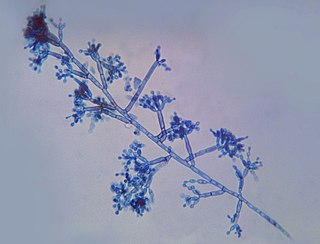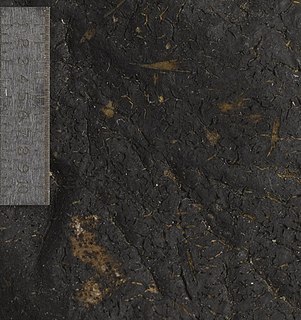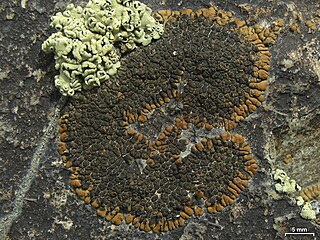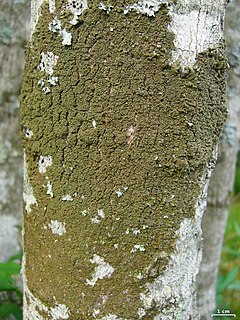Scutula is a genus of lichenicolous fungi in the family Ramalinaceae.

The Chaetothyriales are an order of ascomycetous fungi in the class Eurotiomycetes and within the subclass Chaetothyriomycetidae. The order was circumscribed in 1987 by mycologist Margaret Elizabeth Barr-Bigelow.

The Verrucariaceae are a family of mostly lichenised fungi in the order Verrucariales. The lichen-forming species have a wide variety of thallus forms, and include crustose (crust-like), foliose (bushy), and squamulose (scaly) representatives. There are several dozen lichenicolous (lichen-dwelling) examples in the family, and some genera that contain solely lichenicolous members. An unusually wide variety of photobiont partners have been recorded, mostly green algae, but also brown algae and yellow-green algae. The family, circumscribed nearly two centuries ago, now includes 56 genera and over one thousand species. Most diversity occurring in the temperate climates of the Northern Hemisphere. Rocks and soil are the most common substrates for the Verrucariaceae, with growth on wood and bark less common. Some semi-aquatic lichens occur in this family, including about two dozen species of marine lichens.

Opegrapha is a genus of lichenized fungi in the family Opegraphaceae. Species include:

Stigmidium is a genus of lichenicolous (lichen-eating) fungi in the family Mycosphaerellaceae. The genus was circumscribed by Italian botanist Vittore Benedetto Antonio Trevisan de Saint-Léon in 1860, with Stigmidium schaereri assigned as the type species.

Sphaerellothecium is a genus of fungi in the family Phyllachoraceae. All of the species in the genus are lichenicolous, meaning they grow parasitically on lichens.

Pseudephebe is a genus of fruticose lichens in the family Parmeliaceae. It contains three species that grow on rocks.

Melanohalea is a genus of foliose lichens in the family Parmeliaceae. It contains 30 mostly Northern Hemisphere species that grow on bark or on wood. The genus is characterized by the presence of pseudocyphellae, usually on warts or on the tips of isidia, a non-pored epicortex, and a medulla containing depsidones or lacking secondary compounds. Melanohalea was circumscribed in 2004 as a segregate of the morphologically similar genus Melanelia.

Abrothallus is a genus of lichenicolous fungi. It is the only genus in the monotypic family Abrothallaceae, which itself is the sole taxon in the order Abrothallales.
Rhymbocarpus is a genus of lichenicolous (lichen-dwelling) fungi in the family Cordieritidaceae. It has 10 species. The genus was circumscribed by German mycologist Friedrich Wilhelm Zopf in 1896, with Rhymbocarpus punctiformis assigned as the type species.
Spirographa is a genus of parasitic fungi. It is the sole genus in the monotypic family Spirographaceae, belong to the order Ostropales. The genus was circumscribed by Alexander Zahlbruckner in 1903, with Spirographa spiralis later assigned as the type species in 1923. The family Spirographaceae was circumscribed by Adam Flakus, Javier Etayo and Jolanta Miadlikowska in 2019 on the basis of molecular phylogenetic analysis. They determined that genus Spirographa is an independent lineage in the Ostropales, sister to the clade containing the families Fissurinaceae, Gomphillaceae, and Graphidaceae.

Nesolechia is a genus of parasitic fungi in the family Parmeliaceae. All three species in the genus grow on lichens. Nesolechia probably evolved from a lichen ancestor, as it is closely related to many lichenized species of fungi.

Phacopsis is a genus of lichenicolous (lichen-dwelling) fungi. They are parasites of members of the large lichen family Parmeliaceae, of which they are also a member. Originally proposed by Edmond Tulasne in 1852 to contain 3 species, Phacopsis now contains 10 species, although historically, 33 taxa have been described in the genus. Many of the species are poorly known, some of them having been documented only from the type specimen.

Cordieritidaceae is a family of fungi in the order Cyttariales. Species in this family are saprobes or lichenicolous.
Vezdaea is a genus of crustose lichens in the monotypic family Vezdaeaceae, which itself is the only taxon in the order Vezdaeales. The genus was circumscribed by Elisabeth Tschermak-Woess and Josef Poelt in 1976. The genus name honours Czech lichenologist Antonín Vězda.
Muellerella lichenicola is a species of lichenicolous fungus in the family Verrucariaceae. It was first formally described as a new species in 1826 by Søren Christian Sommerfelt, as Sphaeria lichenicola. David Leslie Hawksworth transferred it to the genus Muellerella in 1979.

Sclerococcum is a genus of lichenicolous fungi in the family Dactylosporaceae.
Polycoccum is a genus of lichenicolous fungi in the family Polycoccaceae. It has about 60 species.
Epibryon is a genus of fungi, and the sole genus in the monogeneric family Epibryaceae. It has about 40 species. Many of the species grow parasitically on bryophytes. The genus was circumscribed by mycologist Peter Döbbeler in 1978; the family by Soili Stenroos and Cecile Gueidan in 2014.
Intralichen is a genus of lichenicolous fungi of uncertain classification in the class Ascomycota. It has four species. The genus was circumscribed by David Leslie Hawksworth and Mariette S. Cole in 2002, with Intralichen christiansenii as the type species.












